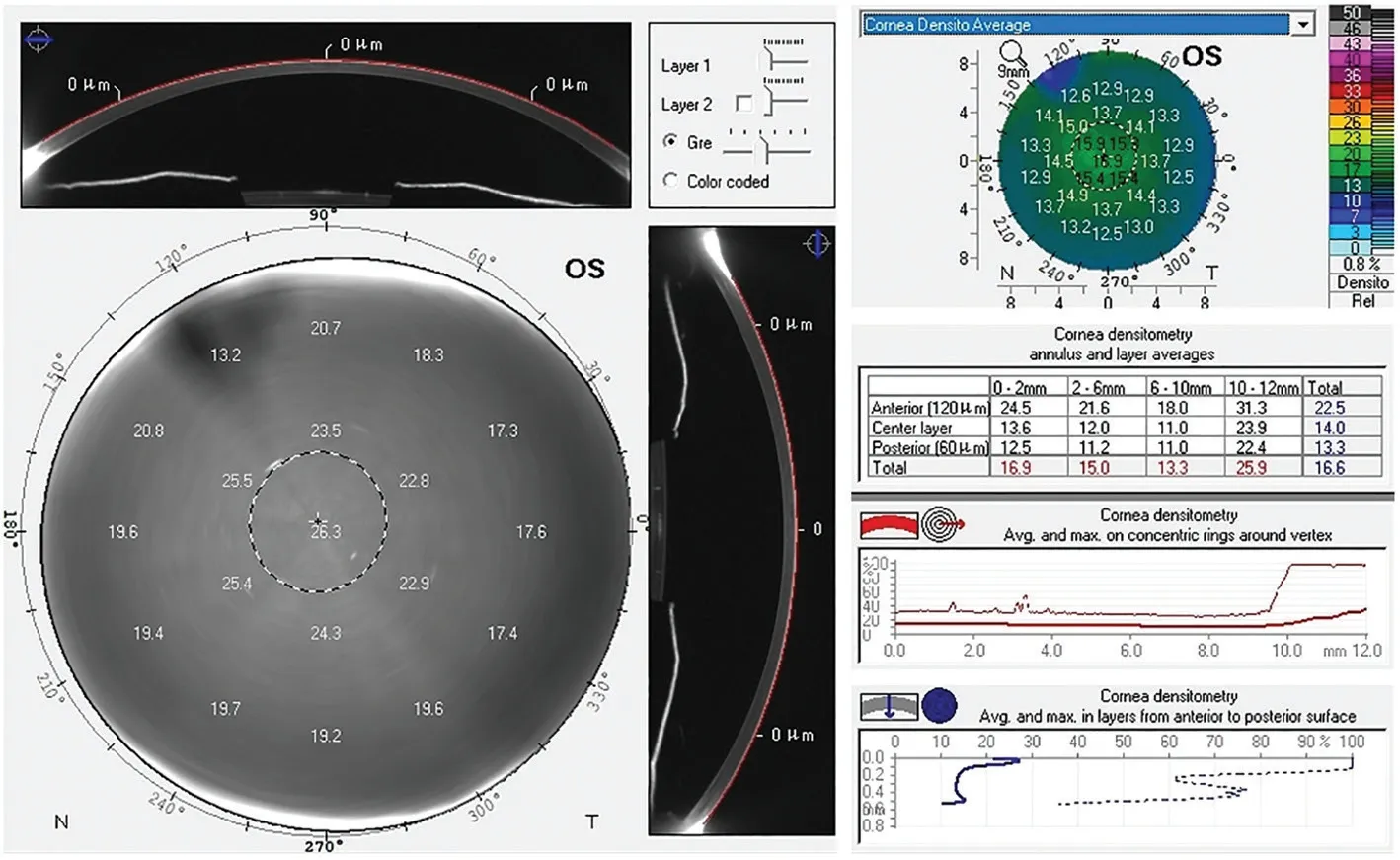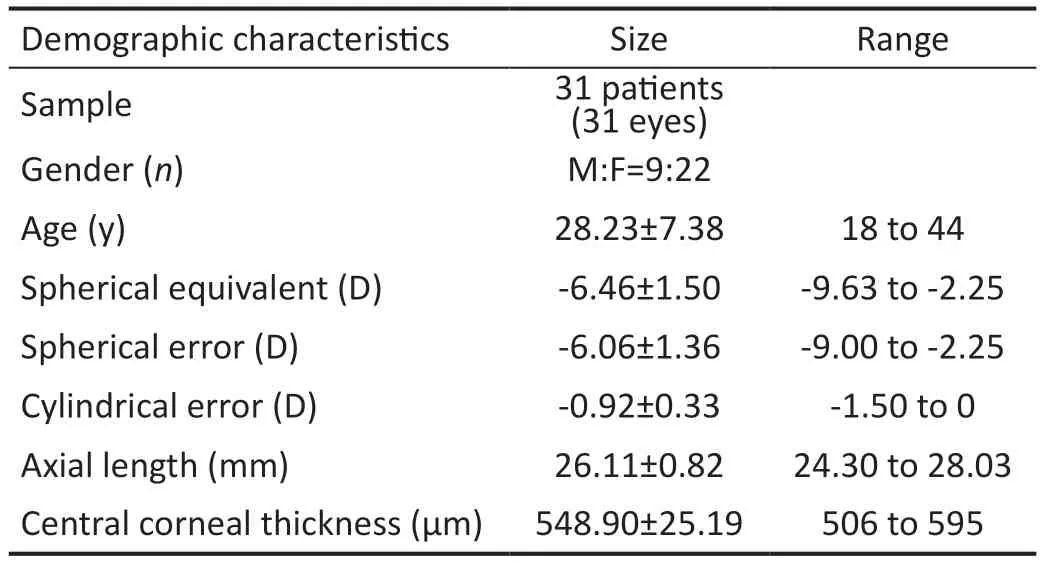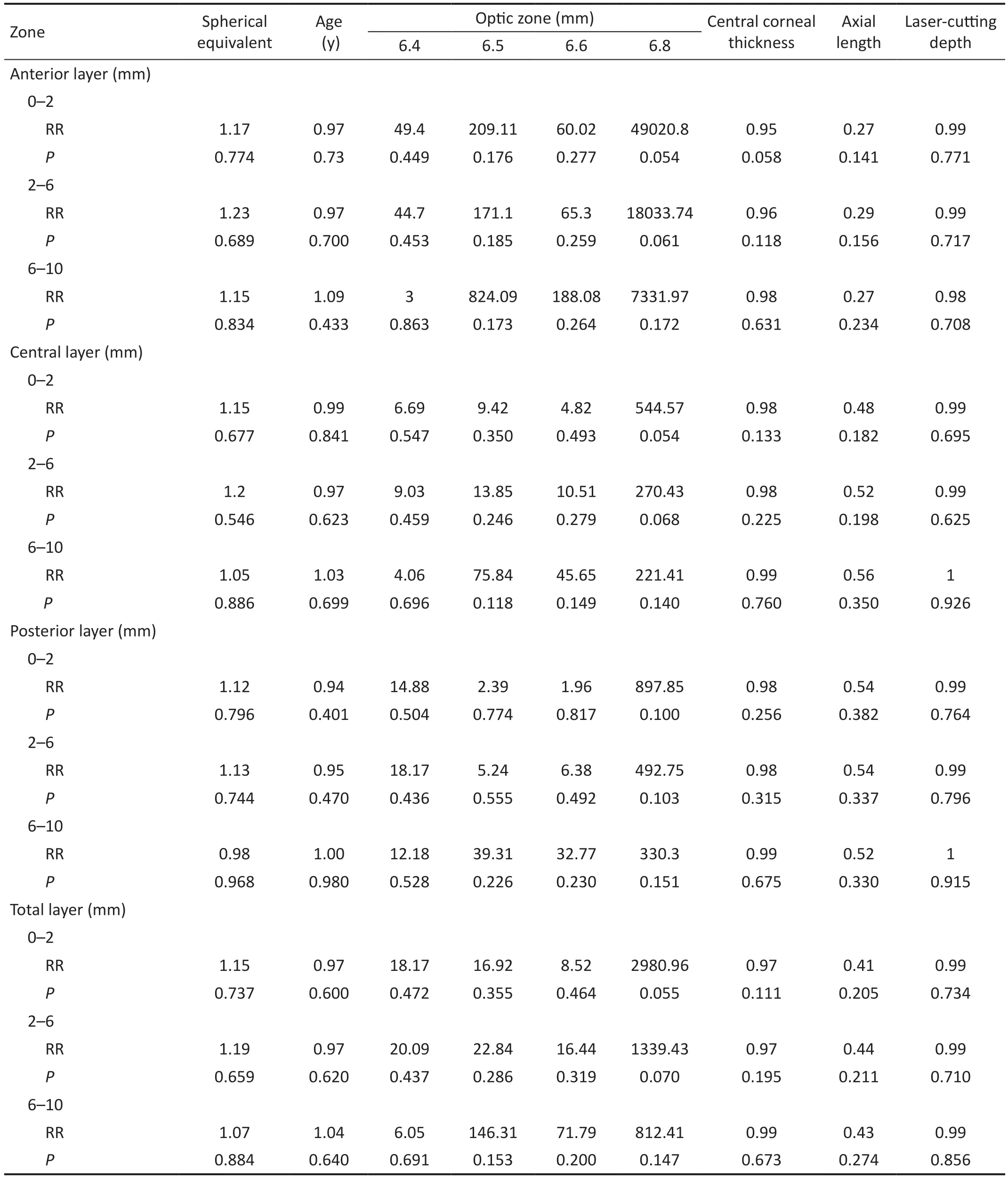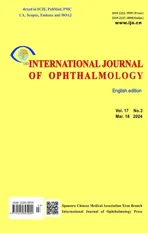Ten-year observation of corneal densitometry and associated factors following small incision lenticule extraction
2024-03-20XiaoSongHanFeiXiaZhuoYiChenPeiJunYaoDongMeiYangJingZhaoXingTaoZhou
Xiao-Song Han, Fei Xia, Zhuo-Yi Chen, Pei-Jun Yao, Dong-Mei Yang,Jing Zhao, Xing-Tao Zhou
1Eye Institute and Department of Ophthalmology, Eye & ENT Hospital, Fudan University, Shanghai 200031, China
2NHC Key Laboratory of Myopia (Fudan University); Key Laboratory of Myopia, Chinese Academy of Medical Sciences,Shanghai 200031, China
3Shanghai Research Center of Ophthalmology and Optometry,Shanghai 200031, China
4Shanghai Engineering Research Center of Laser and Autostereoscopic 3D for Vision Care (20DZ2255000),Shanghai 200031, China
Abstract
● KEYWORDS: myopia; small incision lenticule extraction;corneal densitometry
INTRODUCTION
Transparency is one of the features of a healthy cornea[1].The decrease of transparency occurs in multiple ocular diseases such as keratoconus and high myopia[2].Transparency is a reflection of corneal feature on a certain degree.The subjective examination mainly relies on slit lamp microscopy,while objective on measurement of corneal densitometry(CD)viaPentacam Scheimpflug imaging device.CD is the manifestation of corneal opacification.A higher CD value indicates a stronger absorption of light and a lower transparency.
Myopia has caused global attention as a widespread public health issue.It was indicated that by the year 2050, myopic macular degeneration will cause blindness in one billion people worldwide without intervention[3].As one of the mainstream refractive surgeries, small incision lenticule extraction(SMILE) has the advantages of flaplessness, effectiveness and superior visual qualityviaprecise laser cutting and a small incision of 2 mm[4].The safety, efficiency and predictability of SMILE have been proved by numerous studies[5-7].With SMILE surgeries carried out on a large scale, the condition of long-term postoperative corneal health has been brought to the spotlight.This study aims to investigate on the long-term changes of CD.
SUBJECTS AND METHODS

Figure 1 Display of corneal densitometry on Pentacam.
Ethical ApprovalThe study is in accordance with the tenets of the Declaration of Helsinki and under the approval of the Ethics Committee of the Eye and ENT Hospital of Fudan University with the approval number of KJ2010-18.Written informed consent was obtained from each participant.
SubjectsIn this study, 31 eyes of 31 patients who underwent SMILE surgery in the Eye and ENT Hospital of Fudan University (Shanghai, China) from May 2010 to June 2013 were recruited.
The inclusion criteria were as follows: age of 18y and older,refractive error change within 0.50 D per year for the last 2y,residual corneal stromal bed thickness of 280 μm and more,preoperative sphere no more than -10.00 D and cylinder no more than -1.50 D.Patients with a history of systematic diseases or other ocular diseases, trauma, or surgery were excluded.
Surgical ProcedureAll surgeries were completed by the same surgeon (Zhou XT).Levofloxacin was used 3d in a row before operation.SMILE operation was performed with 500 kHz VisuMax femtosecond laser system with pulse energy of 130 nJ, corneal cap thickness of 100 μm, lenticule diameter of 6.25-6.8 mm, and a 2 mm superior side cut.Detailed procedure was presented in previous studies[8].Antibiotics,steroids and artificial tears were used postoperatively.
Corneal Densitometry MeasurementCD was measured by Pentacam HR (Pentacam HR, Wetzlar, Germany).It captured 25 pictures within 0°-180° range and recorded backscattering of incident light on cornea, which was reflected on CD value.The cornea was horizontally divided into 3 zones: 0-2, 2-6,and 6-10 mm, and vertically anterior layer (120 μm from the anterior surface of the cornea), central layer (between anterior and posterior layer) and posterior layer (60 μm from the posterior surface of the cornea).Display of CD value measurement is shown in Figure 1.
Statistical AnalysisStatistical analysis was performed with R version 4.0.5.Continuous variables were presented asmean±standard deviation (SD) and categorical variables as frequency and percentage.Changes among follow-ups were compared with multi-group distribution ANOVA.Mann-Kendall trend test was used to show the tendency of changes during follow-ups.Associations between relevant variations were analyzed with Generalized Linear Model single-factor analysis.It was statistically significant whenP-value was less than 0.05.

Table 1 Clinical information of patients enrolled
RESULTS
Totally 31 eyes of 31 patients were enrolled in this study.All surgeries were uneventful with 10-year safety index of 1.17±0.20 and efficacy 1.04±0.28.Detailed preoperative proliferation was displayed in Table 1.
10-Year Postoperative RefractionThe54.8% (17/31) of the eyes reported a logMAR uncorrected distance visual acuity(UDVA) of 0 or better 10y after SMILE.The mean spherical error was -0.18±0.50, and cylinder -0.30±0.30.
Corneal Densitometry and Higher-Order AberrationsCD showed statistically significant decrease 5y postoperatively,but returned to preoperative level after 10y except 0-6 zone in central layer (0-2 mmΔ=-1.62, 2-6 mmΔ=-1.24,P<0.01; Table 2,Figure 2).While corneal root mean square (RMS) higher-orderaberration, spherical, coma and vertical trefoil aberration all increased statistically significantly, horizontal trefoil aberration showed decrease without statistical significance (Figure 3).Mann-Kendall trend test revealed that the decrease of CD and higher-order aberrations was not a monotonic trend during 10y of follow-up.

Table 2 Corneal densitometry during 10y of follow-up

Table 3 Corneal densitometry and 6.8 mm optic zone 5y postoperatively
Corneal Densitometry and Associated FactorsIn 1-month follow-up, CD of the 6-10 mm zone of all layers showed weak negative correlation with age [anterior layer: relative risk (RR)=0.83,P=0.016; central layer: RR=0.89,P=0.008;posterior layer: RR=0.92,P=0.043; total layer: RR=0.88,P=0.013].CD of central, posterior, and total layer showed strong positive correlations with 6.8 mm optical zone 5y postoperatively (Table 3).CD showed no correlation with all factors 10y after SMILE.No correlations were observed between CD and spherical equivalent, central corneal thickness, axial length, or laser-cutting depth (Table 4).
DISCUSSION
As one of the corneal laser surgeries, SMILE comes with an even milder wound healing responseviaa 2 mm incision.The fluctuations of CD 3 and 5y after SMILE have been observed[9-10].This is the first report of 10-year postoperative observation of CD, which is with clinical significance and practical value.
In our study, the change of CD values showed a nonmonotonic downward trend 10y after SMILE.Changes of CD values were also observed post implantable collamer lens V4c implantation and accelerated transepithelial corneal collagen cross-linking[11-13], which indicated the importance of follow-up track of CD after corneal surgeries.
It was observed in our study that CD values of the 6-10 mm zone of all layers were weakly negatively correlated with age 1mo postoperatively, but showed no correlation ever since.This was proved by previous studies, which reported that CD in 0-6 mm ring was not correlated with age in healthy eyes[14],and that there was no correlation between CD and age 5y after SMILE[10].Fluctuation of CD within 1mo could be associated with the fact that the incision was in the 6-10 mm zone of the cornea.It was indicated that axial space of collagen fibrils could increase with age[15], which could explain the negative correlation between CD and age 1mo after SMILE.
We found in our study that there was no correlation between CD of all zones in all layers and central corneal thickness postoperatively.It was indicated by previous studies that CD was positively correlated with central corneal thickness in high myopic and keratoconus eyes[2,16], but showed no correlation in normal eyes[17], which is consistent with our findings.Ishikawaet al[18]reported a positive correlation between CD values and postoperative corneal thickness after cataract surgery,indicating that corneal edema undetectable by slit-lamp could be evaluated with CD measurement, which also proved the importance of CD examinations in follow-up visits after corneal surgeries.

Figure 3 Change of higher-order aberrations in different zones.
Interestingly, a strong positive correlation between CD values 5y postoperatively and 6.8 mm optic zone was observed in our study.Water, stromal matrix, stromal cells, and corneal nerves all take parts in maintenance of corneal transparency[19].Considering the long period after surgery, it would be unlikely to trigger corneal nerve reconstruction and tear film instability.The wider corneal injury area may have caused more loss of myofibroblasts[20], resulting in lager collagen gaps with aging.There are a few limitations to our study.On one hand,the sample size is relatively small.On the other hand, the measurement of CD relied on Pentacam only.Multiple ways of acquirement of CD are yet to be evaluated and compared.
In conclusion, SMILE is a safe and efficient procedure for myopia on a long-term basis.CD values get lower 10y postoperatively, whose mechanism is to be further discussed.
ACKNOWLEDGEMENTS
The authors appreciate the contributions of all patients who participated in this study, as well as the stuffin Eye and ENT Hospital of Fudan University for their support.

Table 4 Corneal densitometry and factors 10y postoperatively
Conflicts of Interest:Han XS,None;Xia F,None;Chen ZY,None;Yao PJ,None;Yang DM,None;Zhao J,None;Zhou XT,None.
杂志排行
International Journal of Ophthalmology的其它文章
- Meibomian glands segmentation in infrared images with limited annotation
- Artificial intelligence for the detection of glaucoma with SD-OCT images: a systematic review and Meta-analysis
- Overexpression of TRPV1 activates autophagy in human lens epithelial cells under hyperosmotic stress through Ca2+-dependent AMPK/mTOR pathway
- Dry environment on the expression of lacrimal gland S100A9, Anxa1, and Clu in rats via proteomics
- Semaphorin 7A impairs barrier function in cultured human corneal epithelial cells in a manner dependent on nuclear factor-kappa B
- Novel MIP gene mutation causes autosomal-dominant congenital cataract
